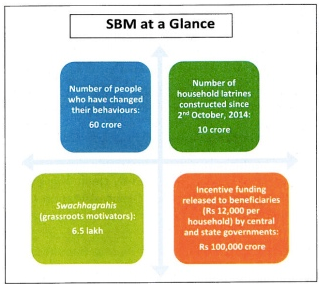

The SwachhSharat Mission (SBM) was launched as a mass movement to bring about behavioral changes for crores of people in India and instill healthy sanitation practices in their daily lives. The socio-economic impact of SBM has been phenomenal both in terms of improving sanitation in hinterland but also improvement in health parameters especially for women and children.
Background:
- In the post-independence phase, health and sanitation aspects were part of the five-year plans. In 1954, the rural sanitation programme in India was introduced as a part of the First Five Year Plan.
- In 1986 a programme - Central Rural Sanitation Programme (CRSP) which solely focused on sanitation was introduced.
- In 1999, Total Sanitation Campaign (TSC) with a vision to eradicate open defecation by 2017 was launched.
- In 2006, TSC was merged with Indira AwasYojana (lAY) and the convergence allowed the use of funds for the construction of sanitary toilets in lAY houses.
- In 2012, the Centre launched Nirmal Bharat Abhiyan (NBA) in convergence with MGNREGA, with an aim to provide 100 percent access to toilets in rural households by 2022.
- In 2014, Prime Minister Shri Narendra Modi led government revamped the NBA into Swachh Bharat Mission (SBM) and introduced two sub-missions - Swachh Bharat Mission (Gramin) and Swachh Bharat Mission (Urban).
- The preparation of District Swachhta Plan (DSP) was the key aspect of SBM which outlined the scope of working to be taken up in a specific district for making it ODF in a time bound manner through ensuring behavior change initiatives. Swachh Bharat AbhiyanGraminwas implemented with the aim of making rural areas in India open defecation free.

The main objectives of SBM(G) are:
- Bring about an improvement in the general quality of life in the rural areas, by promoting cleanliness, hygiene and eliminating open defecation.
- Accelerate sanitation coverage in rural areas
- Motivate communities and Panchayati Raj Institutions to adopt sustainable sanitation practices and facilities through awareness creation and health education.
- Encourage cost effective technologies for ecologically safe and sustainable sanitation
- Develop community managed sanitation systems focusing on scientific solid and liquid waste management systems for overall cleanliness in the rural areas
- Create significant positive impact on gender and promote social inclusion by improving sanitation especially in marginalized communities
Various Initiatives taken up as part of SBM includeNamamiGangeto make villages near Ganga ODF,SwachhSwasthSarvatrato strengthen community health centres, RashtriyaSwachhata Kendra to monitor the progress of SBM programme, Swachhata at Petrol Pumps andSwachh Bharat App & Web Portal to monitor coordination between various departments and ministries.
Impact Assessment of SBM
The UNICEF studied the Financial and Economic Impact of the Swachh Bharat Mission in India in November 2018. Key Findings:
- On an average, households in ODF villages accrued cumulative benefits of Rs.50,000 per year.
- The benefit summarizes reduced medical cost, low disease burden, save labour time and increase in property value from having a latrine.
A study titled - Access to toilets and the safety, convenience and self-respect of women in rural India was conducted in collaboration between UNICEF, Bill & Melinda Gates Foundation (BMGF), Sambodhi Research and Communications Private Limited with assistance from Department of Drinking Water and Sanitation, Ministry of Jal Shakti. Key findings:
- 40% of households having toilet under SBM reports improvement in women safety and reduction in harms by animals while defecating.
- Majority of women feel proud having ownership of toilet.
- 93% of women reported no longer open defecating practices and absence of embarrassment over not having private toilet.
SBM (G)-phase II also referred ODF Plus
The SBM-G Phase II is aimed at generating employment and providing impetus to the rural economy through construction of household toilets and community toilets, as well as infrastructure for SLWM such as compost pits, soak pits, waste stabilization ponds, material recovery facilities etc.
Related Articles

